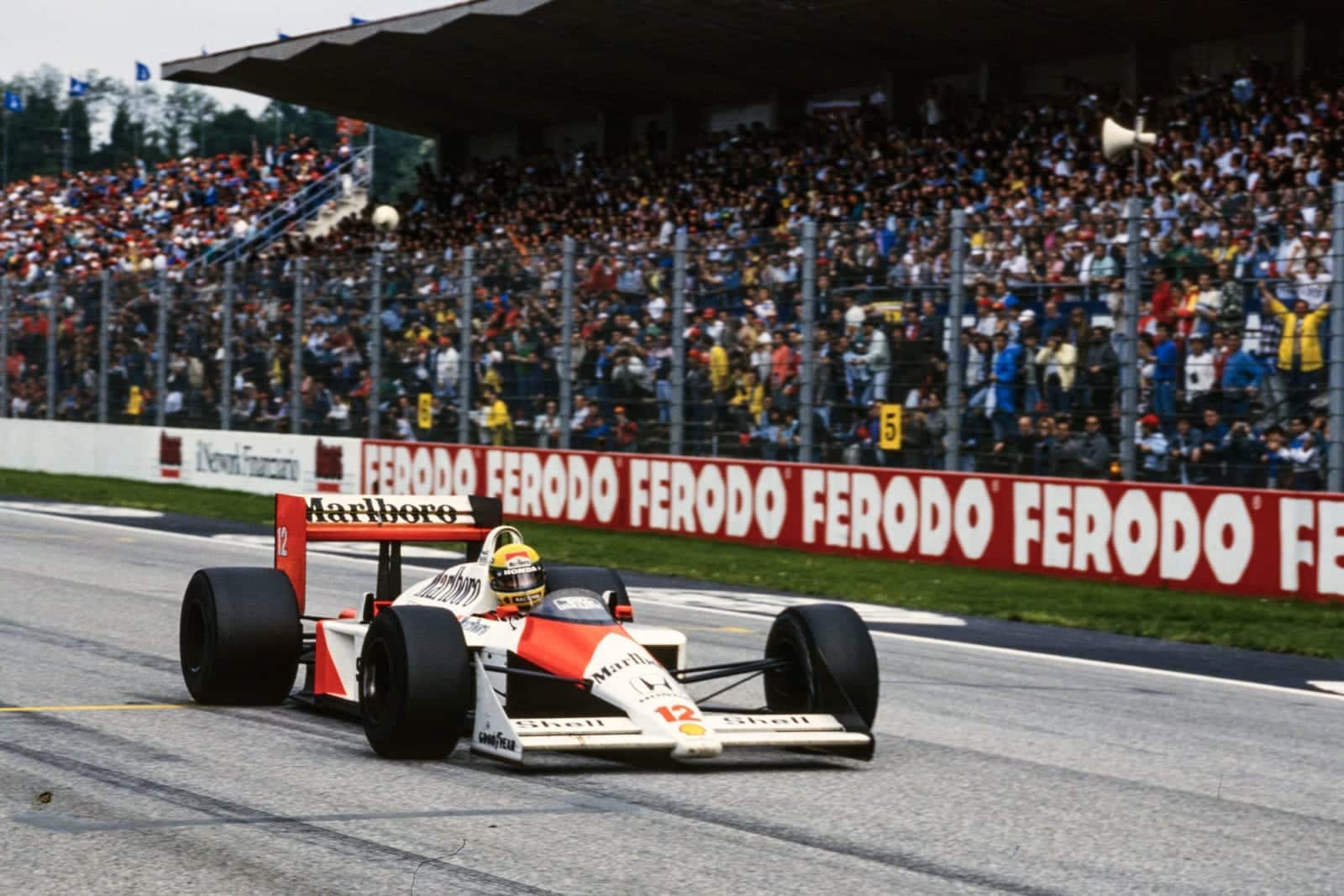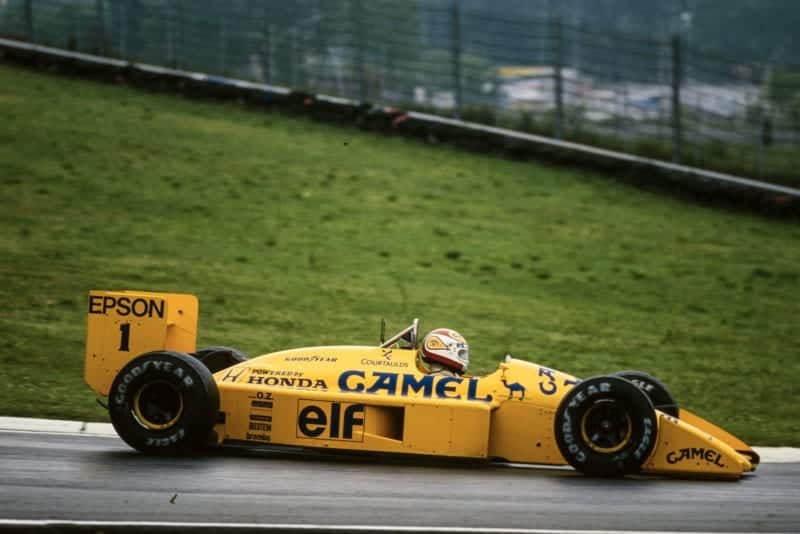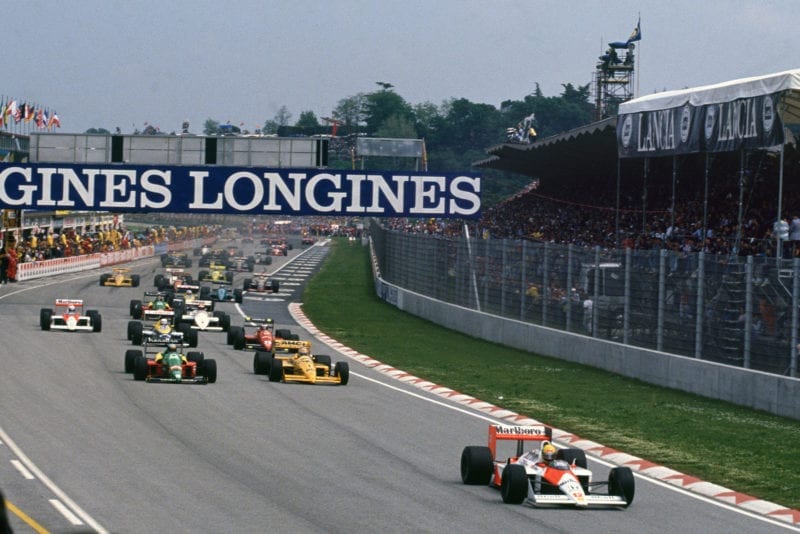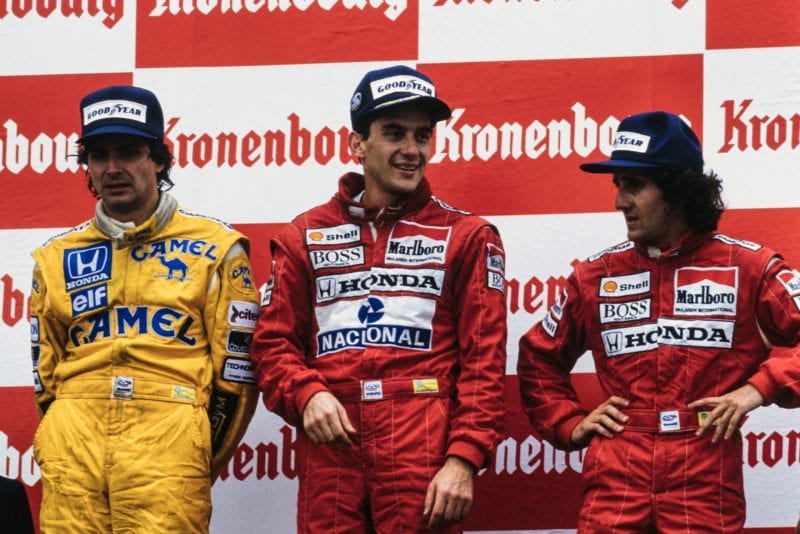1988 San Marino Grand Prix race report

McLaren's Ayrton Senna opened his account for the season with a win
Motorsport Images
Imola, May 1
San Marino Grand Prix
The story of the San Marino Grand Prix itself is simply told.
The two McLaren MP4/4-Honda V6 turbocharged cars simply annihilated every-one, finishing the 60-lap race 2.334 sec apart, but a whole lap in front of the third man. Ayrton Senna was on pole position and led from start to finish, while his team-mate Alain Prost netted the fastest race-lap. In third place was reigning World Champion Nelson Piquet, his Lotus 100T using an identical Honda power plant, but he was nearly three seconds slower on his best lap.
That was the simple part of the San Marino GP. For the rest of the time, from Thursday until Sunday night, it was a disastrous meeting for everyone, the disasters ranging from simple ones easily corrected to major ones which will probably have long term effects.
Thursday is usually a fairly uncomplicated day, with the transporters, motor homes, hospitality-units, trade stands, workshop equipment and racing cars all in position. The scrutineers go quietly about their job of checking all the cars, the paperwork is verified and mechanics can be seen washing off the travel-stains from the huge articulated lorries and trailers, so that everything is spick and span when practice begins on Friday morning.
Most of the teams had already had a test session on the popular Autodromo Dino Ferrari some weeks before, and others had been at Monza the previous week for a final shake-down. But the little Ossella team had to plead for extra time to be scrutineered as its new car was not finished; it had taken last year’s car to Brazil, simply to comply with FISA rules, and had been busy since its return building a 1988 version.
When the car was scrutineered it was turned down on a number of counts, principally to do with the front engine mountings. There was some discussion as to whether it was a 1987 car modified or a totally new car, and if it was new it did not comply with the new rules about the driver’s feet being behind the centre-line of the front wheels. It was not possible to do an instant re-design, so that was the end of Osella’s Grand Prix.

Nelson Piquet in his Lotus was the closest challenger to the McLaren’s in qualifying
Motorsport Images
By lunchtime on Thursday, when the Japanese Leyton House leisurewear group was announcing the establishment of a business headquarters in Milan, and showing us the latest March 881 which it is sponsoring, the rain started drizzling. By mid-afternoon a real storm hit the circuit and everything was awash.
With 31 entries it had been intended that the first part of Friday morning would act as a pre-qualifying session, but the rejection of Nicola Larini’s Osella meant that this was not necessary. Continual rain made conditions very wet and soggy, and we were lucky not to see a lot more cars eliminated during the hour-and-a-half of testing, though Andrea de Cesaris did his best to eliminate the German-sponsored Rial-Cosworth DFZ, a crash into the barriers virtually destroying the car and causing the team to spend the rest of the day building up a new car around its second monocoque, which it had brought with it.
The morning was fairly inconclusive, due to the conditions, but the already large crowd of spectators was beginning to bubble a bit, for Gerhard Berger was second fastest to Senna. In the Benetton team, Alessandro Nannini was everybody’s hero as he made third-best time, ahead of Alboreto.
There seemed to be an enormous number of slow cars about, many of them looking as though they had escaped from Formula 3000; more than ten seconds separated the front runners from the tail-enders, and this was only preparatory testing. The real business had yet to start.
The qualifying hour was pretty damp throughout and everyone was running on treaded “wet” tyres until a few minutes before the end when a dry line began to appear. Some rushed into the pits to change to “slick” tyres, but nobody got into step with conditions and the time of day, and the qualifying hour ended with all the fastest recorded times having been made on treaded tyres, which was not very conclusive for a lot of people. What was conclusive for everyone was the McLaren pair at the top of the list, regardless of conditions.
The rather damp crowd had little to get excited about, for the Ferraris had slipped to third and eighth and were surrounded by normally-aspirated 3½-litre cars. Biggest gloom was in the Lotus pit, for Piquet was over three seconds away from the McLaren, and all Honda engines are supposed to be equal. Having spent 1987 with its cars suspended on computerised air, this year Team Lotus is back on good old-fashioned steel coil-springs, but that was the least of its worries; the 100T just was not fast enough, which suggests aerodynamics and drag factors coming into play.
It had not taken long for it to be obvious that there is a world of difference between a Cosworth DFR and a Cosworth DFZ, both 3½-litre versions of the ubiquitous 21-year-old design. The DFRs as used in the Benettons are works Cosworth engines, heavily backed by Ford, while the rest are “production” engines worked on by various tuners for the various teams. Benetton was proving to be surprisingly quick as far as Nannini was concerned, but Boutsen was having all the trouble with engines breaking internally, some of it self-inflicted by the team due to oversight.
The other serious 3½-litre contender is the Judd V8, as used by the Williams team. It is a fairly bulky power-unit which looks basically solid, and although it is manufactured in England by John Judd its Honda F3000 parentage stands out a mile; it even sounds like a Honda engine.

Senna steals a march at the start
Motorsport Images
With all the expertise and design knowhow of Patrick Head and his engineers, it was to be expected that the resultant Williams package would be more advanced that March or Ligier which are also using Judd engines, while the engine sounds good, it does seem to be running into some internal overheating problems, not simply due to radiators and air flow.
While the Leyton House lot, with their turquoise March cars driven by Ian Capelli and Mauricio Gugelmin were fairly happy, the Ligier team was in total despair, which it cold not blame on the Judd engines.
The JS31 looked pretty awful, giving the impression of not having enough rigidity between the front wheels and the rear wheels, and it seems unnecessarily complicated for no obvious reason. The “boys in blue” must have been the unhappiest drivers at the meeting, which was sad, for Arnoux and Johansson deserve better. The Ferrari team was not exactly radiant and smiling, but at least it was within sight of the front; when you have been at the front, being behind the front-runners comes hard.
On Saturday things became a lot better overall, but at times worse for some – particularly for the vast crowds of spectators with their Ferrari flags at the ready. The weather began to dry up and some serious high-speed driving could be indulged in, which was alright for those with cars which would go high speed. . .
The existing lap record stood at 1 min 28.667 sec to Piquet with a Williams-Honda, and the fastest qualifying lap to Senna with a Lotus-Honda in 1 minute 25.050 sec. with this year’s rules limiting boost-pressure to 2.5-bar (against 4-bar last year), Prost was the only one to break the 1 min 30 sec barrier in the morning test-session. In the afternoon qualifying hour it got worse for the rest, for both McLarens got under 1 min 28 sec, Senna being fastest with 1 min 27.148 sec and Prost second with 1 min 27.919 sec. Nobody else even looked like breaking 1 min 30 sec; among the non-turbo cars, Nannini had the Benetton at the head of the queue, and that queue contained both Ferarris! The crowd were very quiet.
The starting grid was settled during this hour, causing joy, despair, satisfaction, gloom and despondency, depending on which pit you happened to go into.
McLaren was justifiably contented with first and second, though Prost was “miffed” because Arnoux had barged him off the track in the closing minutes, causing light damage to the McLaren. Prost had to walk back to the pits. Honda was closing down its computer terminals, content in the knowledge that its new engines, designed to 2.5-bar boost-pressure, were first, second and third, and had given very few problems. Benetton’s mood was “six of one and half a dozen of the other” for Nannini was the first non-Honda user, but Boutsen never had a chance to show his true ability due to various mechanical troubles. The Williams team was having to face the fact that it was not a front-runner any more, the Judd never really getting on terms with the works Cosworth engines.
Ferrari was totally nonplussed, for the cars had been fast enough in pre-race testing, and were more than fast enough round its own test-track at Fiorano; but races are not run at Fiorano and test-sessions are not what count for the starting grid. Leyton House was happy because Capelli was not only ninth on the grid but ahead of Alboreto’s Ferrari, and of the normal Cosworth users the AGS team had astounded everyone, including its driver, for Philippe Streiff had a very firm position at mid-field.
The Rial team had built a new car and a de Cesaris had kept it on the track to record time, and the little team of Enzo Coloni with its yellow Cosworth-powered car driven by Gabriele Tarquini was happy to have qualified comfortably. Ken Tyrrell got both of his cars onto the grid, with new-boy Julian Bailey ahead of Jonathan Palmer.
Last place on the grid was occupied by the much-vaunted Stefano Modena, driving one of the EruoBrun cars which are difficult to define, with Swiss money, a British Cosworth engine turned in Switzerland, and a car build in Italy but painted white. It did not look as though it would have gone much better in Formula 3000.
The Ligier garages were all closed up and the team was on its way home to Vichy. Neither driver had qualified, and the guillotine was about to fall, except that no-one was quite sure whose head should be on the block.

Alessandro Nannini (left) and Piquet do battle
Motorsport Images
The crowd dispersed through the mud in total silence, and there was an air of disbelief. Ferrari were not on the front row! Not even on the second row! Nannini (Benetton) was ahead of Berger (Ferrari) and Capelli (March) was ahead of Alboreto (Ferrari), and it was a National Holiday tomorrow (May 1), except that it was a Sunday so the holiday had been postponed until Monday. And the rain re-started, to continue most of Saturday evening.
Sunday May 1 was another day, and another day meant there was hope, so the capacity crowd returned to the sea of mud on the hillsides and the wet and soggy stands. They should have stayed at home for things got worse rather than better.
The morning warm-up session merely confirmed what everyone knew, that the McLarens were uncatchable, and the driver error or mechanical failure was the only hope the rest could cling to – both pretty nebulous hopes. The Rial was in trouble again, the new car showing signs of coming “unstitched” even without the driver thumping it into the Armco, and the glue-pot was much in evidence while everyone else prepared for the race.
Just before the cars went out to the dummy-grid, raindrops fell and there was a lot of rushing about juggling between “wet” and “dry” tyres. But by the time everyone was in position and the television moguls were ready for the start, all the cars had settled for “dry” tyres and the impending rain had passed over.
It was not the usual happy and vociferous crowd which overlooked the start, for it was difficult to pick out the two Ferrari cars. Moreover, when Senna was given the green flag to lead the field round on the parade lap, Alboreto cooked his clutch to the slipping point. He was last away, thereby having to say at the back and line up on the starting grid behind Stefano Modena, with his fingers crossed that he could nurse the clutch until it cooled off and gripped properly.
For the anti-McLaren faction, hopes rose when the green starting light came on, for Prost’s Honda engine fluffed and he was swamped by those behind him before it picked up properly. Senna had no problems and was going into an unassailable lead before they reached the first corner. His speed on the opening lap was breathtaking, and he came through the final corners into the start/finish area as if the Devil himself was after him.
From then on it was all over, the Honda engine never missed a beat, the McLaren went superbly and the Brazilian’s only mistake was when he overdid did his braking for the Tosa hairpin on lap 32, got sideways and almost came to a stop, having to snick into first gear to recover. Other than that it was a beautiful exhibition of speed and consistency, his only regret being that he just missed making the fastest race-lap.
After his “muffed” start, Prost finished lap one in sixth place, and cautiously picked his way past Berger, Nannini, Mansell and Piquet to take second position behind Senna on lap eight. The two red-and-white McLarens then simply drove away from everyone, their only excitement being when they lapped the tail-enders, the mid-field runners, and finally the “best of the rest” which included Nelson Piquet in the Lotus 100-Honda. Senna never relaxed his pace, slicing through the back-markers in a most impressive manner, and even more so when he caught the faster runners. None of them troubled him, his lap times were varying very little.
Prost, on the other hand, was being much more cautious ; he knew he could not challenge Senna, so there was little point in taking risks as he passed slower cars. At times he appeared to be hung-up behind slower cars, and his lap times fluctuated quite a bit. Second place was totally secure, so it did not matter much, and once clear he soon regained ground putting in three laps at under 1 min 30 sec, whereas Senna only managed one such lap.
There appeared to be a good race going on for third place, with the two Williams, the two Benettons, Berger’s Ferrari and Cheever’s Arrows-BMW all battling it out behind Piquets Lotus. The reigning World Champion was running to a strict fuel-economy reading, which did not match that of the McLarens using the same engines, so the Yellow Lotus merely stayed in front of the struggling mob behind it.
Nannini got very close at times, even alongside on occasions, until he spun on lap 36, gathering it all up to continue in seventh place. For one brief moment Mansell got his Williams-Judd in front of the Lotus, but Piquet was quite unconcerned, knowing that he was in effect on cruising boost, with enough in hand to be sure of third place, but nothing in hand to help him make any impression on the McLarens.
The Judd engines were on the limit and temperatures of oil and coolant were higher than was desirable. On lap 43 Mansell came free-wheeling into the pits to retire with a dead engine. Patrese in the second Williams had gone well, giving as good as he got from those around him, but a split exhaust-pipe made his engine lose power, and as things got worse he was lucky to limp to the finish.
After two days of troubled practice and qualifying, Thierry Boutsen finally had everything go right and drove a typically smooth and deceptive race to finish fourth, the first of the non-turbo cars and the first without Honda power. Berger spent a very frustrating race fluctuating from fourth to eighth place, but never looking a danger to anyone, and blamed a lack of horsepower for his mediocre performance. On the last lap, in desperation, he chopped across the fast chicane at the top of the circuit to snatch fifth place from a surprised Nannini.
The second Ferrari Never figured at all, for after starting from the back of the grid with his fragile clutch Alboreto seemed to take forever to get by the slowest cars. Though he struggled as high as eighth place, it was not the stuff of which legends are made, and five laps before the finish his engine expired.

Senna celebrates on the podium
Motorsport Images
There were oriental beams all round when the race finished, for Honda engines were 1-2-3, regardless of details, and it was not Honda’s fault that the Lotus could not keep pace with the McLarens, was it? And Nakajima in eighth place? Well, he is still learning the trade of Formula One driver.
If the crowds dispersed quickly and quietly, totally bewildered by the whole affair, it was nothing to the gloom in the paddock. How could the two McLaren-Hondas have lapped the entire field, and without any qualms about fuel consumption on this notoriously thirsty circuit?
We could ask Honda Research & Development, but I don’t think they would tell us. McLaren International personnel merely smiled contentedly and said they were very pleased with their new cars. DSJ
